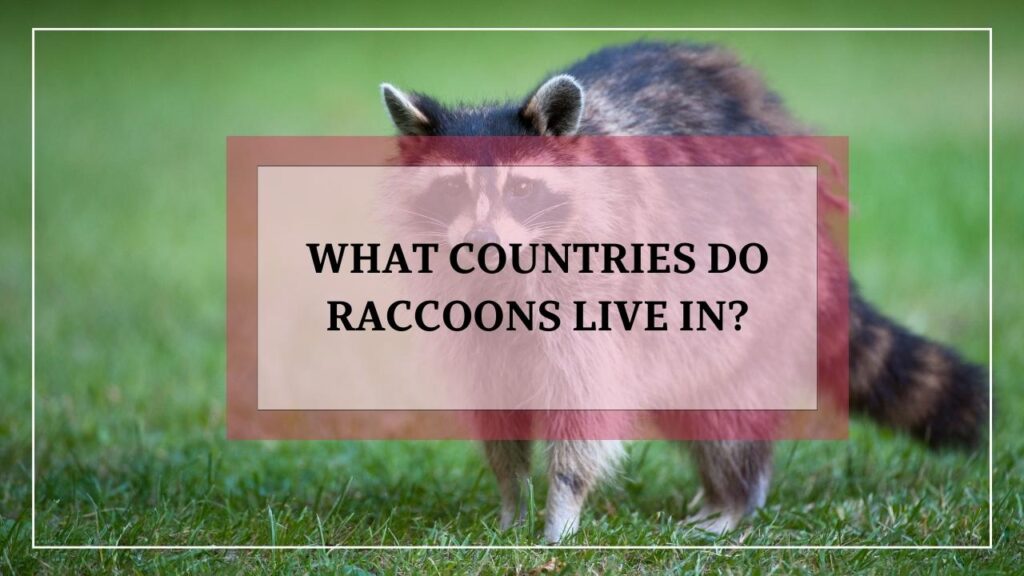Raccoons are clever and mischievous creatures that live in many different countries around the world. Have you ever wondered where these cute little bandits can be found? Well, let’s find out! Raccoons are native to North America, which means they originally lived in places like the United States and Canada. However, they are quite adaptable and have been introduced to other countries too.
Today, you can find raccoons in countries like Germany, Russia, Japan, and even some parts of Europe. These countries provide suitable habitats for raccoons to thrive and explore. So, if you’re ever curious about seeing a raccoon up close, keep an eye out in forests, urban areas, and even your own backyard, because these clever critters could be living nearby!
Native Range of Raccoons
Raccoons are primarily found in North America, but they have also been introduced to other countries. Let’s take a closer look at their native range and where they can be found.
A. North America
In North America, raccoons are widespread and can be found throughout the United States and Canada. They are highly adaptable and can thrive in a variety of habitats, from dense forests to urban areas.
1. United States
Raccoons are present in all 50 states of the United States, making them one of the most common mammals in the country. However, they are more prevalent in the eastern and central regions, where they have larger populations.
Related Article:What Do Raccoons Live?
In states like Texas, Florida, and California, raccoons are particularly abundant due to the availability of suitable habitats and food sources. They are known to be adaptable and can survive in both rural and urban environments.
2. Canada
Raccoons are also native to Canada, where they can be found in various provinces. They are most commonly found in southern Canada, including Ontario, Quebec, and British Columbia. However, they have been known to expand their range further north in recent years.
Canadian raccoons have adapted to colder climates and have thicker fur compared to their southern counterparts. They are skilled climbers and can be found in both urban and rural areas, including parks, forests, and residential neighborhoods.
B. Mexico
In Mexico, raccoons are found in several regions, including the Yucatan Peninsula, the Gulf Coast, and parts of central Mexico. They are known for their ability to adapt to different habitats, ranging from tropical forests to semi-arid areas.
Mexican raccoons often have slightly different behaviors and adaptations compared to their North American counterparts. For example, they may have larger ears and more pronounced facial markings. They are also important seed dispersers in tropical forests, contributing to the regeneration of plant species.
Stay tuned for the next section where we’ll explore how raccoons have been introduced to other countries and their impact on local ecosystems!
Introduction of Raccoons to Other Countries
Related Article: “What Do Raccoons Originate From”
Related Article:What Kind Of Trees Do Raccoons Live In?
Europe
Raccoons are not native to Europe but have been introduced to several countries on the continent. The history of raccoon introductions in Europe dates back to the early 20th century when they were brought over for fur farming. However, some raccoons escaped or were intentionally released into the wild, leading to the establishment of populations in certain countries.
Germany
Germany is one of the countries where raccoons have successfully established populations. They were initially introduced for the fur trade but quickly adapted to the German environment. Raccoons are now commonly found in forests, urban areas, and even farmland. However, their presence has posed challenges for native wildlife, particularly birds and small mammals, as raccoons can outcompete them for food and nesting sites.
Related Article: “What Do Raccoons Do During The Day?”
Russia
Raccoons have also made their way to Russia, particularly in the Moscow region and surrounding areas. Their introduction is believed to have occurred during the 1930s and 1940s, when raccoons were imported for fur farming. Today, they can be found in both urban and rural settings, taking advantage of the varied habitats available. However, their presence has raised concerns about potential impacts on native species and ecosystems.
Japan
The introduction of raccoons to Japan is quite unique and has an interesting backstory. In the 1970s, a popular Japanese anime called “Rascal the Raccoon” depicted a pet raccoon named Rascal, which led to a surge in demand for raccoons as pets. However, many owners eventually released their raccoons into the wild when they became too difficult to handle. As a result, raccoon populations established themselves in certain regions of Japan. This introduction has had significant impacts on local wildlife, particularly bird populations and agricultural crops.
Other countries where raccoons have been introduced
Aside from Europe and Japan, raccoons have been introduced to various other countries around the world. Some notable examples include Argentina and Uruguay in South America. These introductions were mainly driven by the fur trade and have resulted in established populations. However, concerns have been raised about potential impacts on native species and the spread of diseases.
Overall, the introduction of raccoons to other countries highlights the adaptability and resilience of these creatures. While they may have found new homes in foreign lands, it is important to carefully manage their populations and minimize any negative impacts on native wildlife and ecosystems.
Habitat Preferences of Raccoons
Raccoons are incredibly adaptable creatures, which is one of the reasons why they have managed to thrive in various environments. Let’s take a closer look at where raccoons prefer to make their homes.
Related Article:What Do Raccoons Eat In Captivity?
Related Article: “What Do Raccoons Do To Humans”
Forested Areas
Raccoons are well-suited for life in forested areas. They have the amazing ability to adapt to both deciduous and coniferous forests, which means you can find them in a wide range of wooded habitats. Whether it’s the dense forests of the Pacific Northwest or the sprawling woodlands of the Appalachian Mountains, raccoons are right at home.
In these forest ecosystems, raccoons take advantage of the abundance of food sources. They are skilled climbers, allowing them to scavenge for fruits, berries, and nuts in the treetops. Raccoons are also opportunistic hunters and will take advantage of small mammals, birds, and eggs when the opportunity presents itself.
Urban Environments
If you live in a city or suburb, chances are you’ve encountered a raccoon or two. These resourceful critters have become quite adept at thriving in urban settings. From raiding trash cans to making themselves at home in attics and crawl spaces, raccoons have learned to adapt to the challenges and opportunities that come with city life.
Cities like Toronto and Chicago have sizable raccoon populations, with these clever creatures making their homes in parks, gardens, and even abandoned buildings. Raccoons have a knack for finding food sources in urban areas, whether it’s scavenging for leftovers or hunting small rodents that also call the city home.
Wetlands and Riparian Zones
Raccoons are also drawn to wetland habitats and riparian zones. These areas, characterized by the presence of water and abundant vegetation, provide raccoons with ample opportunities for foraging and hunting.
Wetlands offer a smorgasbord of food options for raccoons. They can feast on fish, amphibians, crustaceans, and a variety of plant matter. Raccoons are excellent swimmers, and their dexterous paws allow them to search for food in the water. They have even been known to dunk their food in water before eating, a behavior known as “dousing.”
Related Article:What Do Raccoons Eat In Florida?
In riparian zones, raccoons can be found along riverbanks and streams. These areas provide a mix of terrestrial and aquatic food sources, allowing raccoons to diversify their diet. With their natural curiosity and adaptability, raccoons make the most of the resources available in these unique habitats.
So, whether it’s the deep forests, bustling cities, or serene wetlands, raccoons have proven time and time again that they can thrive in a wide range of environments. Their ability to adapt and find food sources in different habitats is truly remarkable.
FAQs
Related Article: “What Time Of Day Do Raccoons Come Out”
1. What countries do raccoons live in?
Raccoons are native to North America, specifically found in the United States and Canada. However, due to human intervention and introduction, raccoons have also been introduced to various countries around the world, including Germany, Russia, Japan, and several countries in Europe.
Related Article: “What Do Raccoons Need To Survive”
2. Are raccoons found in the United Kingdom?
No, raccoons are not native to the United Kingdom. However, there have been occasional reports of escaped or released pet raccoons in the UK. These sightings are rare, and the UK government actively discourages keeping raccoons as pets due to the potential risks they pose to native wildlife.
3. Can raccoons be found in Africa?
No, raccoons are not native to Africa. They are primarily found in North America. Raccoons have not been introduced or established in any African countries, as they require specific habitats and environmental conditions that are not present on the African continent.
Conclusion
In conclusion, raccoons are fascinating creatures that have adapted to various habitats around the world. Native to North America, they are widely distributed across the United States and Canada, with specific regions and habitats where they are more prevalent. Raccoons have also been introduced to other countries, such as Germany, Russia, and Japan, where they have established populations with varying impacts on local wildlife and ecosystems.
Related Article:What Do Raccoons Do In The Winter?
Raccoons are highly adaptable and can thrive in a range of environments, including forested areas, urban settings, and wetlands. Their nocturnal behavior, omnivorous diet, and unique social structure contribute to their survival and success. However, their presence in human-populated areas can sometimes lead to conflicts, requiring responsible wildlife management strategies and public awareness to promote coexistence.
It is important to be mindful of disease concerns associated with raccoons, such as rabies, and to support conservation efforts aimed at protecting these animals. Through education and conservation organizations, we can better understand raccoons and their role in ecosystems, ensuring a harmonious coexistence between humans and wildlife.
We hope this blog post has provided you with valuable insights into the world of raccoons. If you have any experiences or questions about raccoons, we encourage you to share them in the comments section below. Let’s continue learning and exploring the wonders of the animal kingdom together!

Hi, I’m Ali Tarek, the founder of Animalsman. I’ve always been passionate about pets, especially dogs and cats, and I created this website to share practical tips, easy recipes, and helpful care advice for fellow pet lovers. My goal is to make pet care simple, enjoyable, and accessible for everyone. When I’m not writing or curating content, you’ll usually find me spending time with my furry friends or learning new ways to keep them happy and healthy.



